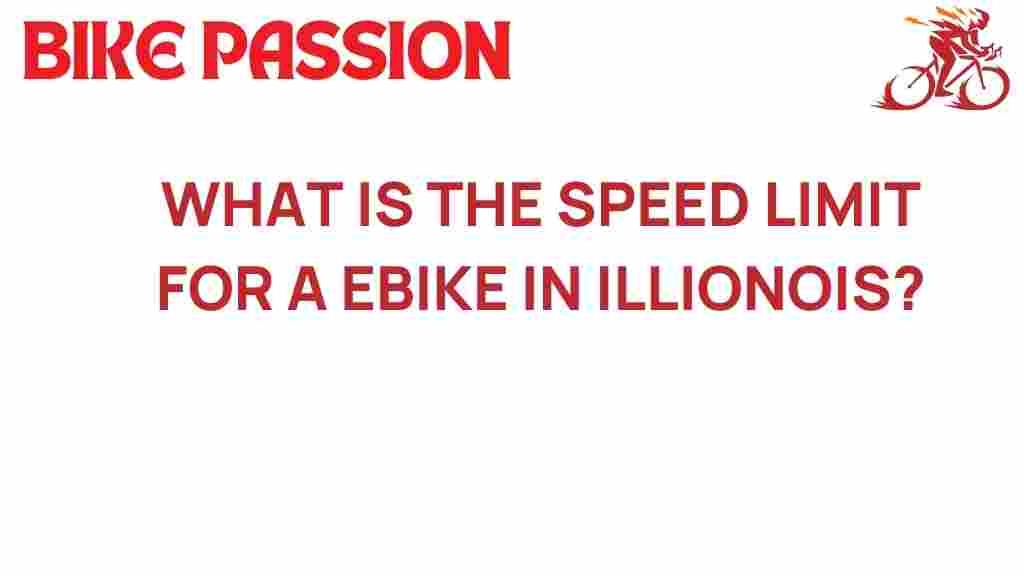What You Need to Know About eBike Speed Limits in Illinois
As the popularity of electric bikes, or eBikes, continues to grow in Illinois, so does the need for understanding the speed limits, regulations, and laws surrounding their use. Whether you are a seasoned cyclist or a newcomer to the world of electric transportation, knowing the rules regarding eBike operation is essential for your safety and compliance with local laws. In this article, we will explore the current speed limits for eBikes in Illinois, the relevant regulations, and offer some safety tips for cycling enthusiasts.
Understanding eBike Classifications
Before diving into speed limits and regulations, it’s important to understand the classifications of eBikes as defined by Illinois law. The state categorizes eBikes into three classes:
- Class 1: These are electric bikes equipped with a motor that provides assistance only when the rider is pedaling and ceases to function when the bike reaches a speed of 20 mph.
- Class 2: These eBikes have a motor that can propel the bike without pedaling, but the motor assistance stops when the bike reaches 20 mph.
- Class 3: These bikes can assist the rider even while pedaling, up to a maximum speed of 28 mph. Riders of Class 3 eBikes must be at least 16 years old and wear a helmet.
Speed Limits for eBikes in Illinois
In Illinois, the speed limits for eBikes are primarily determined by their classification:
- For Class 1 and Class 2 eBikes, the speed limit is set at 20 mph when operating on bike paths or multi-use trails.
- Class 3 eBikes are allowed to reach speeds of up to 28 mph, but they are restricted from operating on bike paths unless local ordinances allow it.
Understanding these speed limits is crucial for eBike users to avoid fines and ensure a safe riding experience.
Regulations Governing eBikes in Illinois
Illinois has specific regulations that govern the operation of eBikes, which are important for both safety and legality:
- Riders must be at least 16 years old to operate a Class 3 eBike.
- Helmet use is mandatory for Class 3 riders, but it is highly recommended for riders of all classes.
- eBikes are not permitted on sidewalks unless local laws allow it.
- Riders must adhere to all traffic laws, including stopping at stop signs and traffic signals.
- eBikes must be equipped with a working brake system and lights for nighttime riding.
It’s advisable to check local regulations as they can vary by municipality. Some cities may have additional restrictions or rules regarding eBike operation.
Safety Tips for eBike Riders
While understanding speed limits and regulations is vital, ensuring your safety as an eBike rider is equally important. Here are some tips to enhance your cycling safety:
- Wear a Helmet: Always wear a properly fitted helmet, especially if you’re riding a Class 3 eBike.
- Stay Visible: Use reflective gear and lights, especially at night or in low-light conditions.
- Follow Traffic Laws: Obey all traffic signals and road signs. Remember, eBikes are classified as bicycles in Illinois.
- Be Aware of Your Surroundings: Always be alert to pedestrians, vehicles, and other cyclists.
- Maintain Your eBike: Regularly check your brakes, tires, and battery to ensure everything is in working order.
Common Troubleshooting Tips for eBike Riders
Even with proper maintenance, eBikes can sometimes encounter issues. Here are some common problems and how to troubleshoot them:
Battery Issues
If your eBike isn’t providing assistance, it may be a battery issue. Here’s what to check:
- Ensure the battery is fully charged.
- Check for any loose connections between the battery and the motor.
- Inspect the battery for any physical damage.
Motor Malfunction
If the motor is not engaging, consider the following:
- Check the motor for any obstructions.
- Inspect the wiring for any fraying or damage.
- Make sure the motor is clean and free of dirt.
Flat Tires
Flat tires are one of the most common issues. Follow these steps:
- Inspect the tire for punctures or wear.
- Inflate the tire to the recommended pressure.
- Replace the tire if it’s beyond repair.
If you encounter persistent issues, it may be wise to consult a professional mechanic or technician familiar with electric bikes.
eBikes as a Sustainable Transportation Option
eBikes not only offer a fun way to cycle but also serve as a sustainable transportation option. Here are some benefits of using eBikes:
- Eco-Friendly: eBikes produce zero emissions and contribute to reducing your carbon footprint.
- Cost-Effective: They save money on fuel and parking, making them a practical choice for commuting.
- Health Benefits: Riding an eBike encourages physical activity, which can improve overall health.
- Reduced Traffic Congestion: eBikes can help alleviate traffic problems in urban areas.
Conclusion
Understanding the speed limits, regulations, and safety protocols surrounding eBikes in Illinois is crucial for a safe and enjoyable cycling experience. As more people turn to electric bikes as a viable form of transportation, being informed will help you navigate the roads responsibly. Remember, adhering to local laws and practicing safety measures can enhance your riding experience while contributing to a more sustainable future.
If you’re interested in learning more about eBike regulations in different states or other cycling-related topics, feel free to explore more resources here.
For further information on eBike laws and regulations, you can visit the Illinois Department of Transportation website.
This article is in the category Tech and created by BikePassion Team
